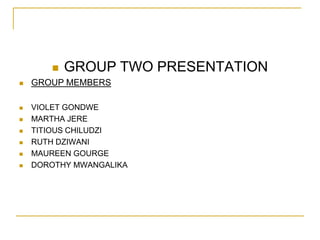
Pericarditis
- 1. GROUP TWO PRESENTATION GROUP MEMBERS VIOLET GONDWE MARTHA JERE TITIOUS CHILUDZI RUTH DZIWANI MAUREEN GOURGE DOROTHY MWANGALIKA
- 2. PERICADITIS BROAD OBJECTIVES By the end of this presentation, student nurses should be able to acquire knowledge and skills on managing pericarditis. SPECIFIC OBJECTIVES Define pericarditis Explain etiology and pathophysiology Name the clinical manifestation of pericarditis Its diagnostic evaluation studies Nursing assessment and diagnosis Nursing management Medical surgical management and know its complications
- 3. DEFINITION Pericaditis refers to an inflammation of a visceral or pericardium which is a membranous sac enveloping the heart (Phillip (2010) medical surgical nursing .
- 4. Pericaditis can be acute or chronic. Acute pericarditis occurs due to complications of infections, immunological conditions or even as a result of heart attack. Chronic pericarditis is however less common a form of constrictive pericarditis. It can also be a primary illness which develop as a result of medical and surgical disorders
- 5. ETIOLOGY Chemotherapy Radiation therapy Trauma and surgical interventions Infections e.g bacteria fungal and viral Renal failure Tuberculosis Disorders of connective tissue
- 6. PATHOPHYSIOLOGY ACUTE In acute pericarditis when microbes are inhaled or ingested, they migrate to myocardium and cause inflammation. So when these membranes are inflamed, they rub against each other and cause classic sounds of which the patient complains of severe chest pains which increases when the patient lies supine and decreases when in sitting position. This acute inflammation causes accumulation of fluid in the pericardial sac called pericardial effusion. The fluid may be serus which accompanies heart failure, purulent accompanying tuberculosis and haemorrhage accompanying trauma in the heart.
- 7. Patho acute cont’ed The excessive accumulation of fluid in the sac causes compression of the heart, resulting in decrease venous retain of the heart resulting in ventricular filling and a decrease in stroke volume. These events will eventuary lead to cardiac failure, shock and death.
- 8. CHRONIC Chronic pericarditis occurs when the layers adhere to each other causing fibrosis of the pericardial sac due to surgery which later restrict movement of the heart. So the fibrosis pericardium tightens the heart decreasing cardiac filling and output and later patient may report symptoms of heart failure.
- 9. CLINICAL MANIFESTATION Sharp chest pain with a rapid onset that worsens when an individual breaths, coughs and changes position Mild fever of 37.5 to 38 degrees Celsius Anaemia Chest pain Chills Night sweats
- 10. DIAGNOSTIC EVALUATIN STUDIES ECG which detect inflammation, pericardial effusion and heart failure CT scan to determine location of pericardial effusion Biopsy of pericardium to obtain tissue sample for culture and microscopic examination
- 11. NURSING ASSESMENT Physical assessment to obtain the base line data Vital signs Assess patient in various positions in order to detect pain whether it is influenced by respiratory movements, coughing and swallowing
- 12. NURSING DIAGNOSIS Ineffective breathing pattern related to chest pain Altered thermoregulation , hyperthermia, related to infection and inflammation as evidenced by temp of 37.5 to 38 degrees Celsius Altered comfort pain related to inflammation of the pericardium Risk for cardiogenic shock related to decreased cardiac output Ineffective tissue perfusion related to decrease blood flow Anxiety related to therapeutic interventions and uncertainty of prognosis.
- 13. NURSING MANAGEMENT Explain every procedure to the patient in order to get consent, cooperation and array anxiety. Position patient in semi fowlers to relieve pain and allow expansion of chest for effective breathing Explain the pathophysiology to the patient Encourage gradual increase activity Monitor vital signs closely to detect infections
- 14. MEDICAL MANAGEMENT Administer analgesics, paracetamol 1g orally 6hrly for pain relief Indocid to decrease coronary blood flow Drainage of pericardial fluid Aspirin as 300mg orally 6hrly as an antiflammation
- 15. COMPLICATION Pericarditis progresses to heart failure Peripheral oedema Increase systemic venous pressure
- 16. REFERENCES Smeltzer S.C, Bare B.G. & Hinke J.L (1999). Brunner & Suddarth’s textbook of medical surgical nursing. (9th E.D). Philadelphia: J.B. Lippincott Linton A.D (2007) Introduction to medical – surgical nursing. (4th ed) Saunders Elsevier.
